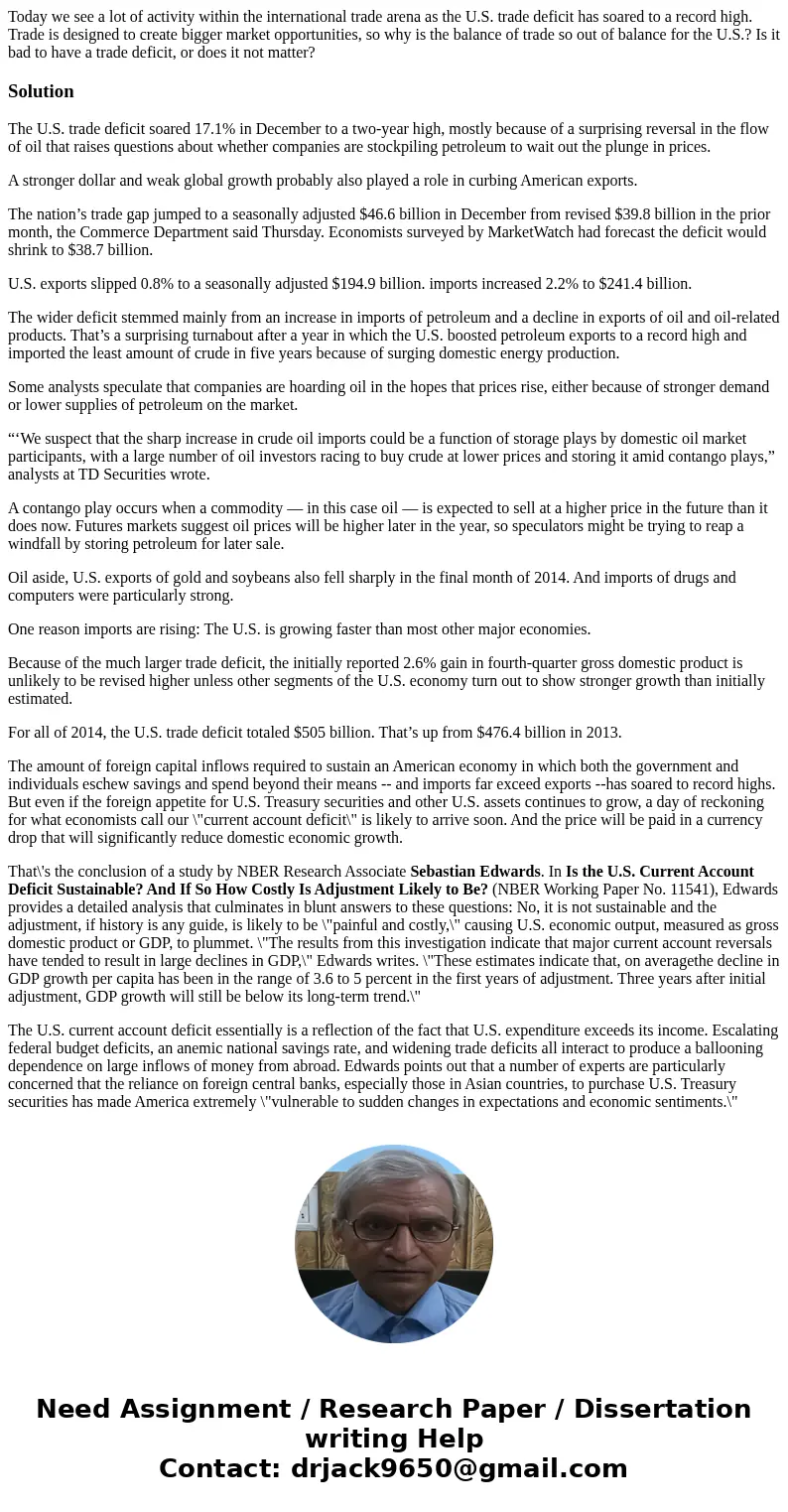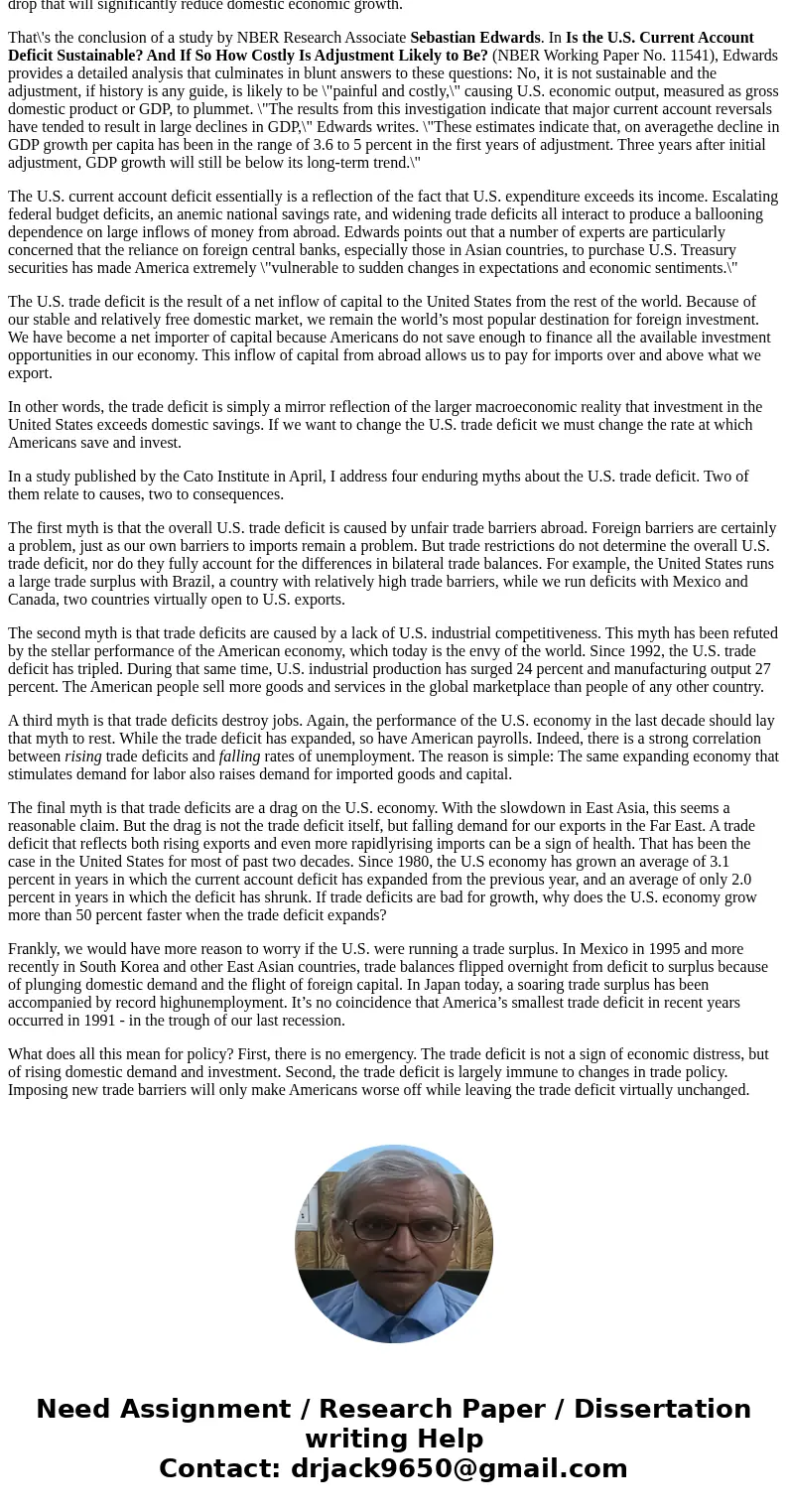Today we see a lot of activity within the international trad
Today we see a lot of activity within the international trade arena as the U.S. trade deficit has soared to a record high. Trade is designed to create bigger market opportunities, so why is the balance of trade so out of balance for the U.S.? Is it bad to have a trade deficit, or does it not matter?
Solution
The U.S. trade deficit soared 17.1% in December to a two-year high, mostly because of a surprising reversal in the flow of oil that raises questions about whether companies are stockpiling petroleum to wait out the plunge in prices.
A stronger dollar and weak global growth probably also played a role in curbing American exports.
The nation’s trade gap jumped to a seasonally adjusted $46.6 billion in December from revised $39.8 billion in the prior month, the Commerce Department said Thursday. Economists surveyed by MarketWatch had forecast the deficit would shrink to $38.7 billion.
U.S. exports slipped 0.8% to a seasonally adjusted $194.9 billion. imports increased 2.2% to $241.4 billion.
The wider deficit stemmed mainly from an increase in imports of petroleum and a decline in exports of oil and oil-related products. That’s a surprising turnabout after a year in which the U.S. boosted petroleum exports to a record high and imported the least amount of crude in five years because of surging domestic energy production.
Some analysts speculate that companies are hoarding oil in the hopes that prices rise, either because of stronger demand or lower supplies of petroleum on the market.
“‘We suspect that the sharp increase in crude oil imports could be a function of storage plays by domestic oil market participants, with a large number of oil investors racing to buy crude at lower prices and storing it amid contango plays,” analysts at TD Securities wrote.
A contango play occurs when a commodity — in this case oil — is expected to sell at a higher price in the future than it does now. Futures markets suggest oil prices will be higher later in the year, so speculators might be trying to reap a windfall by storing petroleum for later sale.
Oil aside, U.S. exports of gold and soybeans also fell sharply in the final month of 2014. And imports of drugs and computers were particularly strong.
One reason imports are rising: The U.S. is growing faster than most other major economies.
Because of the much larger trade deficit, the initially reported 2.6% gain in fourth-quarter gross domestic product is unlikely to be revised higher unless other segments of the U.S. economy turn out to show stronger growth than initially estimated.
For all of 2014, the U.S. trade deficit totaled $505 billion. That’s up from $476.4 billion in 2013.
The amount of foreign capital inflows required to sustain an American economy in which both the government and individuals eschew savings and spend beyond their means -- and imports far exceed exports --has soared to record highs. But even if the foreign appetite for U.S. Treasury securities and other U.S. assets continues to grow, a day of reckoning for what economists call our \"current account deficit\" is likely to arrive soon. And the price will be paid in a currency drop that will significantly reduce domestic economic growth.
That\'s the conclusion of a study by NBER Research Associate Sebastian Edwards. In Is the U.S. Current Account Deficit Sustainable? And If So How Costly Is Adjustment Likely to Be? (NBER Working Paper No. 11541), Edwards provides a detailed analysis that culminates in blunt answers to these questions: No, it is not sustainable and the adjustment, if history is any guide, is likely to be \"painful and costly,\" causing U.S. economic output, measured as gross domestic product or GDP, to plummet. \"The results from this investigation indicate that major current account reversals have tended to result in large declines in GDP,\" Edwards writes. \"These estimates indicate that, on averagethe decline in GDP growth per capita has been in the range of 3.6 to 5 percent in the first years of adjustment. Three years after initial adjustment, GDP growth will still be below its long-term trend.\"
The U.S. current account deficit essentially is a reflection of the fact that U.S. expenditure exceeds its income. Escalating federal budget deficits, an anemic national savings rate, and widening trade deficits all interact to produce a ballooning dependence on large inflows of money from abroad. Edwards points out that a number of experts are particularly concerned that the reliance on foreign central banks, especially those in Asian countries, to purchase U.S. Treasury securities has made America extremely \"vulnerable to sudden changes in expectations and economic sentiments.\"
The U.S. trade deficit is the result of a net inflow of capital to the United States from the rest of the world. Because of our stable and relatively free domestic market, we remain the world’s most popular destination for foreign investment. We have become a net importer of capital because Americans do not save enough to finance all the available investment opportunities in our economy. This inflow of capital from abroad allows us to pay for imports over and above what we export.
In other words, the trade deficit is simply a mirror reflection of the larger macroeconomic reality that investment in the United States exceeds domestic savings. If we want to change the U.S. trade deficit we must change the rate at which Americans save and invest.
In a study published by the Cato Institute in April, I address four enduring myths about the U.S. trade deficit. Two of them relate to causes, two to consequences.
The first myth is that the overall U.S. trade deficit is caused by unfair trade barriers abroad. Foreign barriers are certainly a problem, just as our own barriers to imports remain a problem. But trade restrictions do not determine the overall U.S. trade deficit, nor do they fully account for the differences in bilateral trade balances. For example, the United States runs a large trade surplus with Brazil, a country with relatively high trade barriers, while we run deficits with Mexico and Canada, two countries virtually open to U.S. exports.
The second myth is that trade deficits are caused by a lack of U.S. industrial competitiveness. This myth has been refuted by the stellar performance of the American economy, which today is the envy of the world. Since 1992, the U.S. trade deficit has tripled. During that same time, U.S. industrial production has surged 24 percent and manufacturing output 27 percent. The American people sell more goods and services in the global marketplace than people of any other country.
A third myth is that trade deficits destroy jobs. Again, the performance of the U.S. economy in the last decade should lay that myth to rest. While the trade deficit has expanded, so have American payrolls. Indeed, there is a strong correlation between rising trade deficits and falling rates of unemployment. The reason is simple: The same expanding economy that stimulates demand for labor also raises demand for imported goods and capital.
The final myth is that trade deficits are a drag on the U.S. economy. With the slowdown in East Asia, this seems a reasonable claim. But the drag is not the trade deficit itself, but falling demand for our exports in the Far East. A trade deficit that reflects both rising exports and even more rapidlyrising imports can be a sign of health. That has been the case in the United States for most of past two decades. Since 1980, the U.S economy has grown an average of 3.1 percent in years in which the current account deficit has expanded from the previous year, and an average of only 2.0 percent in years in which the deficit has shrunk. If trade deficits are bad for growth, why does the U.S. economy grow more than 50 percent faster when the trade deficit expands?
Frankly, we would have more reason to worry if the U.S. were running a trade surplus. In Mexico in 1995 and more recently in South Korea and other East Asian countries, trade balances flipped overnight from deficit to surplus because of plunging domestic demand and the flight of foreign capital. In Japan today, a soaring trade surplus has been accompanied by record highunemployment. It’s no coincidence that America’s smallest trade deficit in recent years occurred in 1991 - in the trough of our last recession.
What does all this mean for policy? First, there is no emergency. The trade deficit is not a sign of economic distress, but of rising domestic demand and investment. Second, the trade deficit is largely immune to changes in trade policy. Imposing new trade barriers will only make Americans worse off while leaving the trade deficit virtually unchanged.


 Homework Sourse
Homework Sourse